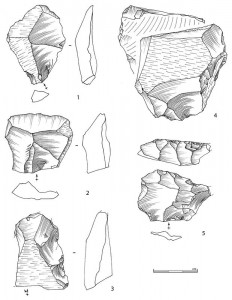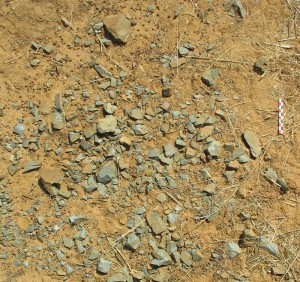The Palaeolithic of the Falémé Valley
Several studies in the Falémé Valley in the 1970s-1980s by A. Camara and B. Duboscq led to the recognition of Palaeolithic occupations from different periods and cultures (bifacial shaping, knapping, foliate pieces, etc.) (Camara, Duboscq, 1984, 1987, 1990). However, no direct dates were obtained and as a result, no clear chronological framework is available to understand the chronocultural succession and patterns of occupation in the region.
It is in this context, and in comparison with Ounjougou (Mali), the only reference sequence in West Africa, that we have developed since 2012 our work on the Palaeolithic in the Falémé Valley. Our aim is to construct a second chronostratigraphic sequence exploitable in terms of settlement dynamics. Indeed, the proximity of the Saharan and Sahelian bands raises questions regarding human adaptive behaviors faced with changes in humidity and aridity in their environment. At Ounjougou for example, the lack of occupations during isotopic stage 2, particularly dry (Rasse et al., 2004; Soriano et al., 2010), has been noted. The position of the Falémé further south and its pattern of occupation (continuous or discontinuous?) is an element of discussion in the issues related to the persistence of settlement and the mobility of human groups.
Our field surveys, mainly in 2012 and 2013 between Gouloungina and Tomboura, have identified several dozen sites with lithic artifacts, especially in stratigraphic context. Such wealth leads to hopes of technical, cultural and chronological information of high quality.
Among the surveyed sites, the Ravin des Guêpiers and Fatandi V have now been tested and excavated. The first, exposed by intense erosion in a relatively thick sedimentary sequence, has yielded a small lithic assemblage highly localized stratigraphically and characterized by simple knapping sequences. After sampling in February 2013, OSL dating of the sequence is in progress.
For Fatandi V, plans of the knapping debris concentration visible on the surface were made in 2012. These led in particular to the identification Levallois and blade production for which the question of their association remains. Excavation of a 30 m long trench in 2013 focused on excavation of a concentration being dismantled and recognition of the archaeological and chronostratigraphic potential. This enabled clarification of our taphonomic hypotheses and the discovery of a rich new and uneroded lithic concentration. Its excavation is in progress and will be extensively excavated in 2014. Levallois and blade production have been identified, associated with less elaborate reduction processes. Initial sampling for OSL dating has been done.
Finally, coarse formations at Alinguel, Ravin des Guêpiers, Sansandé and Lalli have yielded many artifacts that appear archaic (bifacial pieces, discoidal cores, large Levallois flakes, simple reduction sequences, etc.), although all have been rolled. Identification of some of these artifacts in stratigraphic context and sampling for OSL dating of silty or sandy horizons may make it possible to obtain direct chronostratigraphic information for these industries for the first time in West Africa.
Bibliography
CAMARA, A.; DUBOSCQ, B.; 1984: Le gisement préhistorique de Sansandé, basse vallée de la Falémé, Sénégal. Approche typologique et stratigraphique. L’Anthropologie, t. 88, n° 3, pp. 377-402.
CAMARA, A.; DUBOSCQ, B.; 1987: Contexte chronostratigraphique des outillages du Paléolithique évolué dans l’Est du Sénégal. L’Anthropologie, t. 91, n° 2, pp. 511-520.
CAMARA, A.; DUBOSCQ, B.; 1990: La fouille d’un site acheuléen à Djita (basse vallée de la Falémé, Sénégal). L’Anthropologie, t. 94, n° 2, pp. 293–304.
RASSE, M.; SORIANO, S.; TRIBOLO, C.; STOKES, S.; HUYSECOM, E.; 2004: La séquence pléistocène supérieur d’Ounjougou (Pays Dogon, Mali): évolution géomorphologique, enregistrements sédimentaires et changements culturels. Quaternaire, vol. 15, n° 4, pp. 329-341.
SORIANO, S.; RASSE, M.; TRIBOLO, C.; HUYSECOM, É.; 2010: Ounjougou (Pays dogon, Mali): une séquence à haute résolution pour le Paléolithique moyen d’Afrique sahélienne. Afrique: Archéologies & Arts, vol. 6, pp. 49-66.


